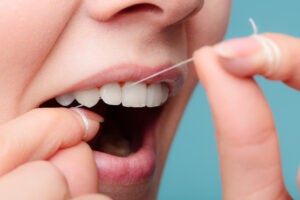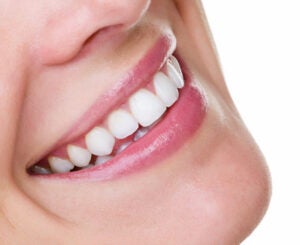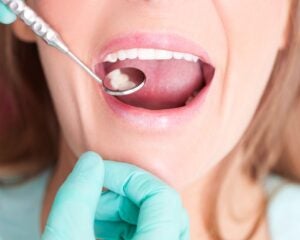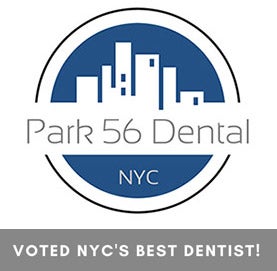-
A Step-by-Step Guide for Proper Flossing

The benefits of flossing include superior plaque removal, healthier gums, and a lower chance of cavities. Perhaps you intend to add this good habit to your oral care routine, but you’re not sure how to floss. Follow this step-by-step guide for the best results.
How to Floss Your Teeth
- Break off 18 inches of floss from the spool and wrap the ends around your middle fingers.
- Grasp the floss with your thumb and forefinger to secure it better and prevent squeezing your middle fingers.
- Guide the floss between two teeth at a time, being careful not to snap it against your gums, as this could cause trauma to the soft tissue.
- Glide the floss up and down, arching it into a c-shape so it rubs against one tooth and then the other. Extend the floss down below the gum line to remove plaque buildup here as well.
- Gently remove the floss from between your teeth.
- Repeat this process throughout your entire mouth. Be sure to floss behind your back molars as well.
- Every few teeth, wipe the collected debris onto a facial tissue and shift to a clean section of floss.
- Dispose of the used piece of floss in a trash can, not the toilet.
If your gums bleed when you floss, this could be a sign of gum disease. Flossing strengthens your gums, so keep up the habit, and the bleeding should subside after about two weeks.
Flossing with Braces
Because food and plaque are more likely to become trapped under bands and wires, flossing when you have braces is very important. Special stiff floss makes it easier to thread under your braces so you can pass it between your teeth. You may also opt for a flossing alternative to complete the task more quickly.
Alternatives to Traditional Floss
If you dread flossing because you have braces, or you simply don’t feel coordinated enough to do it properly, try an alternative to traditional dental floss. Here are your options:
- Dental floss picks are the closest equivalent to regular floss. They consist of a bit of floss stretched between a u-shaped piece of plastic. A small handle lets you comfortably hold the floss pick without having to wrap floss around your fingers.
- Interdental picks feature short rubber tines attached to a small handle. The increased size of the flossing material makes it easier to clean more thoroughly between larger gaps or areas with receding gums.
- A water flosser is a mechanical device that sprays a fine jet of water between your teeth to remove food particles and plaque quickly and easily. It’s a great choice for people who hate the feeling of floss scraping against their teeth.
Talk to your dentist about which flossing product may be best for you.
Ready to discuss your oral care routine? Have a concern about flossing every day? Please contact Park 56 Dental at (212) 826-2322 for advice from a leading NYC dentist.
-
How Sugar Affects Your Teeth

Everyone knows sugar is bad for your oral health, but few people know why. Once you understand how sugar affects your teeth, you may be less tempted to indulge in Halloween candy and other sweets during the holidays.
How Cavities Form
Your mouth is home to hundreds of different types of bacteria. Some are beneficial, but others cause cavities. When you eat sweets, some of the sugar lingers on your teeth. Harmful bacteria eat these leftovers and leave acids and plaque behind.
Without proper oral hygiene, the accumulation of acid lowers the pH balance in your mouth. This causes demineralization, or the removal of minerals from the hard outer surface of your teeth known as enamel. As your enamel erodes, holes form in your teeth. The damage eventually progresses deeper and deeper until it causes pain and tooth loss.
Reducing the Effects of Sugar on Your Teeth
A constant battle is raging in your mouth between bacteria and tooth enamel. Fortunately, you have an effective weapon on your side—saliva. In addition to breaking down food as it enters your digestive system, saliva helps to remineralize your teeth with calcium, phosphates, and other minerals.
It’s possible to fill cavities and restore your smile, but it’s best to avoid tooth decay in the first place. Here’s how to give your saliva a fighting chance against the onslaught of sugars and acids in your mouth:
- Limit your sugar intake by eating less Halloween candy and other sweets during the upcoming holiday season.
- Brush your teeth after eating sugary food. If that’s not possible, chew sugarless gum or swish with water to wash away any lingering sugar in your mouth.
- Satisfy your sweet tooth with xylitol, a natural sugar alcohol that has the same sweetness as sugar but is not a viable food source for bacteria.
- Limit between-meal snacks to give your saliva a chance to wash away acid and repair your teeth before the next meal.
- Don’t eat or drink anything sugary between brushing your teeth and going to bed. Likewise, never send your child to bed with juice, which introduces sugar to the mouth just when saliva flow decreases during sleep.
- Consider dental sealants, a product that covers the chewing surfaces of a child’s molars to protect this rough, pitted area from bacteria.
- Seek out fluoride. This mineral helps prevent tooth decay and can even reverse cavities in their early stages. Drink fluoridated water, brush with fluoride toothpaste, and ask about fluoride treatments at your next dentist visit.
The best way to avoid cavities is to combine at-home oral hygiene tips with routine teeth cleanings at Park 56 Dental. Our experienced dental team will check on the condition of your smile, clean and polish your teeth, and address any cavities that are developing before they grow any larger. To schedule your next appointment, please contact Park 56 Dental online or call our NYC dentist today at (212) 826-2322.
-
How You Can Get the Smile You Want with Veneers

Your smile is one of the first things people notice about you. If you have flawed teeth, you may be all too aware of this, smiling with closed lips or covering your mouth with your hand to hide them. What if you could smile confidently? With veneers, you can!
A veneer is a thin, custom-made shell that bonds to the front of your tooth. It’s made of tooth-colored material, such as porcelain, which is carefully matched to your existing teeth for a completely natural finish. Here’s how you can get the smile you want with veneers.
Straighten Crooked Teeth
Veneers aren’t meant to replace orthodontic treatment, but if you have crooked teeth, this could be an option. An oral exam and digital X-rays are the best way to determine if braces or veneers will improve your smile most effectively over the long term.
Fill in the Gaps
You want your teeth to sit snugly side-by-side. If there are gaps between some of them, your mouth may appear neglected and be more vulnerable to cavities and gum disease. You could bring your teeth together manually with braces or a retainer, but if the gaps are caused by small teeth rather than poor alignment, veneers could be the superior solution.
Correct Discoloration
Have you tried to whiten your discolored teeth without success? While professional in-office teeth whitening can remove surface stains, it can’t touch deep stains or discoloration caused by traumatic tooth injury. Fortunately, veneers can! As long as your teeth are healthy, you can cover them with custom-made veneers in a sparkling shade of white.
Hide Imperfections
Is one of your front teeth longer than the other? Are you self-conscious about a snaggletooth? Maybe one or two of your teeth are smaller than the rest. Whether uneven, worn, or oddly shaped, veneers can almost certainly hide your imperfect teeth.
Smooth out Chipped Teeth
Tooth enamel is the hardest material in the body, but it’s not impervious to chipping. Veneers restore your appearance by smoothing out chips, making them invisible. Anyone who sees you smile after having this restoration work performed will only notice beautiful, healthy-looking teeth.
The Veneer Procedure
When you set an appointment at Park 56 Dental to discuss your cosmetic dentistry questions, we’ll show you what veneers can do. If you decide to move forward, we’ll begin the restoration process by taking impressions of your teeth. Custom veneers are made based on these impressions for a precise fit.
On the day of your fitting, the dentist will prepare your teeth by shaving them down slightly so the veneers align with your natural teeth. Next, the veneers are attached using dental cement. A curing laser speeds up the drying process and ensures a permanent bond. After a final cleaning and polishing, you’ll be left with the beautiful smile you’ve always wanted!
To learn more about hiding flawed teeth with veneers, or to schedule a consultation with our NYC dentist, please contact Park 56 Dental at (212) 826-2322.
-
How Poor Dental Hygiene Affects Your Overall Health

You probably know that if you don’t take good care of your teeth and gums, you increase your risk for cavities, gum disease, and bad breath. But are you aware that oral health can affect the rest of your body? Connections have been discovered between decreasing oral health and many seemingly unrelated diseases and conditions. Learn more about this connection here, as well as how to maintain a healthy mouth and body.
Heart Disease
When your gums are damaged and infected because of gum disease, oral bacteria can enter your bloodstream directly through this soft tissue. This allows bacteria to travel to your heart, where clots can form as a result. A condition called endocarditis, or inflammation of the inner lining of the heart, may also develop.
Chronic gum inflammation also emits chemicals that can cause atherosclerosis, or the clogging and hardening of artery walls. This health condition blocks blood flow, increasing the risk of heart attack and stroke.
Dementia
The harmful bacteria that grow when you have gum disease don’t only travel to your heart—they also enter the brain, where they kill brain cells and lead to memory loss. This may increase the chance of developing dementia or Alzheimer’s disease.
Respiratory Infections
It’s possible to inhale oral bacteria that form because of gum disease. Once in the lungs, the bacteria can cause infections, pneumonia, acute bronchitis, and even chronic obstructive pulmonary disease (COPD).
Diabetes
Gum disease and diabetes are a dangerous combination. If you are diabetic, you are more susceptible to infections, including gum disease. Then, if you have gum disease, this heightens your risk for high blood sugar, which can lead to diabetes or worsen your existing symptoms. And if you have both conditions at once, you have a higher chance of developing kidney disease.
Rheumatoid Arthritis
Oral bacteria from gingivitis can increase inflammation throughout the body. This makes people with gum disease more likely to develop rheumatoid arthritis, a painful and debilitating inflammatory condition.
Pregnancy Complications
Hormonal changes during pregnancy increase the risk of oral health problems. Then, developing gingivitis or periodontitis can lead to premature birth, low birth weight, and other health issues for mother and baby.
Maintain Good Oral Hygiene to Protect Your Overall Health
The message is clear: good oral hygiene can do more than preserve your teeth and gums—it can keep your whole body healthy. To discourage the problems that often accompany gum disease, remember to follow these tips:
- Brush your teeth morning and night with fluoride toothpaste.
- Floss daily.
- Chew sugarless gum after meals.
- Avoid cigarettes and chewing tobacco.
- Eat a well-balanced diet and limit your sugar intake.
- Seek fluoride treatment from your dentist.
- Schedule teeth cleanings and dental checkups every six months.
If it’s been a while since your last dentist visit, set an appointment at Park 56 Dental by calling us at (212) 826-2322. We’ll check the status of your teeth and gums and recommend a treatment plan if necessary.
RECENT POSTS
categories
- Uncategorized
- Cosmetic Dentistry
- Veneers
- Healthier Teeth
- Teeth Whitening
- Dental Health
- Video
- Dental Emergencies
- Invisalign
- Dental Implants
- Root Canal
- Sedation Dentistry
- Infographic
- Dental Crowns and Bridges
- Dental Anxiety
- Gum Disease
- COVID-19
- Bad Breath
- New York Dentist
- Cut out sugar
- General Dentistry
- Oral Health
- Oral Cancer
- Dry Mouth
- Gum Health
- Toothache
- Dental Sealants
- Cavities
